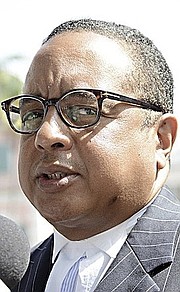• Bank victorious in one of two ‘highest risk’ legal fights
• Judge: ‘Arguable defence with prospect of success’
• Ex-Cabinet minister owns 50% of opposing company
By NEIL HARTNELL
Tribune Business Editor
nhartnell@tribunemedia.net
Bank of The Bahamas yesterday emerged victorious in one of its two “highest risk” legal battles after a $6m default judgment against it was found to have been “irregularly” obtained.
Justice Petra Hanna-Adderley upheld a prior decision to overturn the October 23, 2017, default entered against the BISX-listed institution by a group of companies alleged to have links to a former Cabinet minister.
Her verdict recorded evidence that Damian Gomez QC, former minister of state for legal affairs, was said to be a 50 percent beneficial owner in one of the plaintiff companies, Seaport Construction Ltd, “and may have an interest in the other” corporate entities. The legal dispute with the bank was behind his decision to resign from the Cabinet in 2015.
Besides finding that Bank of The Bahamas had “an arguable defence with a prospect of success” to the claims, the judge also ruled that the “judgment in default of defence” was obtained irregularly because it needed the Supreme Court’s prior approval.
Her verdict thus enables the commercial bank, which is more than 82 percent owned by the Government, to breathe a little easier given that the battle with entities forming the Freeport-based MRC (Meridian Research Corporation) group was ranked as its most important legal dispute alongside the battle with ex-Cabinet minister Leslie Miller.
Wayne Aranha, now Bank of The Bahamas’ former chairman, told shareholders in its 2021 annual report: “In the matter of Kaydee Ltd et al versus Bank of The Bahamas, the bank awaits the delivery of the appeal ruling stemming from the ‘judgment in default of defence’ entered against the bank by the plaintiffs in excess of $6m, which was set aside on October 21, 2019.”
Justice Hanna-Adderley, setting out the background to the dispute, said it stemmed from the MRC Group’s allegations that Bank of the Bahamas had failed to follow through on various mortgage contracts agreed with it, resulting in its various entities suffering what was initially claimed to be $14.085m in losses and damages.
David Edward Jennette III, as trustee and general counsel to Seaport, one of the MRC entities, had sought in 2009-2010 to secure credit facilities from Bank of The Bahamas as a means to refinance non-bank loans that had become “onerous “ to the group.
He dealt with John Sands, Bank of The Bahamas’ then-senior manager for the northern Bahamas. However, Indira Deal, the bank’s legal counsel, alleged in an affidavit filed as part of the dispute that Mr Sands had been dismissed in May 2011 “for gross misconduct, and he was previously suspended for his role in extending unathorised credit facilities to Seaport and individuals related to Seaport.
“In addition, a report was made to the Commercial Crimes Unit of the Royal Bahamas Police Force in September 2011 in relation to potentially fraudulent transactions entered into by Mr Sands and individuals connected to Seaport and the fifth plaintiff, Meridian Research Corporation,” Ms Deal further claimed.
Those “individuals” were not identified, and there is no suggestion Mr Gomez did anything wrong in relation to this matter. Justice Hanna-Adderley’s judgment makes no mention of what happened to the police investigation.
However, Mr Jennette and the MRC Group companies successfully obtained a default judgment against Bank of The Bahamas on March 31, 2016, after it failed to appear in response to the action it filed over the loans dispute and associated damages.
That first default ruling was set aside prior to then-acting Supreme Court justice, Andrew Forbes, ordering that the dispute proceed to trial in traditional fashion before the Supreme Court. Yet Bank of The Bahamas failed to submit its defence in time, leading to another default ruling.
That was granted three years ago in October 2017, and Mr Jennette and the MRC Group subsequently obtained the $6m-plus damages award against Bank of The Bahamas on March 7, 2019, before moving to enforce it. The BISX-listed institution, though, successfully persuaded the deputy Supreme Court registrar to set that aside, too, leading to the appeal before Justice Hanna-Adderley.
Ms Deal, in her affidavit, sought to explain Bank of The Bahamas’ failure to meet the Supreme Court’s deadlines by disclosing that Chancellors Chambers, the law firm originally hired to defend its interests, had split-up by early January 2018.
“One partner left and joined the chambers of Damian Gomez QC, who is connected to the plaintiffs in these proceedings as a beneficial owner of 50 percent [of] Seaport Construction and may have an interest in the other plaintiff companies, and the other members of Chancellors formed a new chambers called Providence Law,” she recalled.
“Providence and the bank appear to have mistakenly believed that the transfer of the plaintiffs’ portfolios to Resolve meant that the bank was no longer dealing with the plaintiffs’ claims against the bank, and that Providence were therefore instructed to ceases take any action in relation to the plaintiffs’ claims.”
Resolve is Bahamas Resolve, the Government-created special purpose vehicle (SPV) to which Bank of The Bahamas’ toxic commercial loans were transferred in 2014 and 2017 as part of the two taxpayer-financed bailouts of the BISX-listed institution. The MRC Group loans were among the facilities passed to Bahamas Resolve.
Providence Law subsequently informed the KPMG accounting firm, Bank of The Bahamas’ external auditors, on August 22, 2018, that the judgment in default of defence had been entered in favour of MRC Group and Mr Jennette.
The letter was copied to the bank’s financial controller, Jihanne Hosmillo-Williams, but she had not been previously involved in the legal battle and “and appears not to have realised that the bank needed to take any action”.
This, Ms Deal asserted, may have been because Providence Law informed her that the loans had been transferred to Bahamas Resolve. As a result, Bank of The Bahamas’ legal department only became aware of the situation on April 29, 2019, some seven weeks after the $6.049m damages were awarded to MRC and Mr Jennette.
Justice Hanna-Adderley found in favour of submissions by Dawson Malone, the Callenders & Co attorney representing Bank of The Bahamas, that the Supreme Court’s deputy registrar had the necessary powers to set aside the default judgment.
And she also backed Mr Malone’s contention that Bank of The Bahamas has a strong and arguable defence to the claims against it. “The plaintiffs have already accepted that many of the alleged claims are spurious in reducing their claims from approximately $14m to approximately $3.7m at the assessment of damages (when the bank had not even entered its defence),” he had argued.
Bank of The Bahamas, in its defence, said a probe by the Graham, Thompson & Co law firm that was carried out on its behalf “concluded that there was good reason to believe” that several borrowers connected to the MRC Group, and aided by Mr Sands, had “induced the bank to make loans on the basis of fraudulent information presented to the bank”.
And Seaport had been placed in receivership under Philip Galanis, the HLB Galanis & Company accountant and partner, via a Supreme Court order in 2011. “
“The order restricting Seaport from dealing with its assets, and placing it in receivership, was made as a result of a claim by Mr Damian Gomez in relation to fraudulent conveyances by Seaport to third parties similar in kind to those described above,” Bank of The Bahamas’ defence asserted.






Comments
tribanon 2 years, 2 months ago
It's easy to connect the dots here. Damian Gomez, John Sands, James Smith, Philip Galanis......all slimey and sleazy corrupt birds of a feather.
Sign in to comment
Or login with:
OpenID